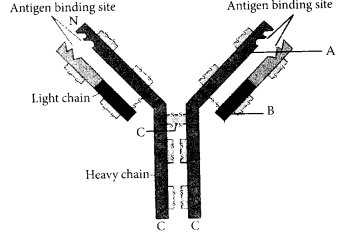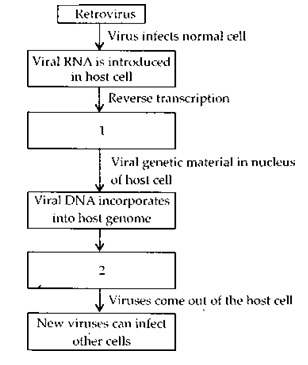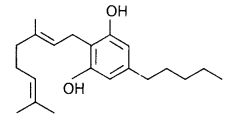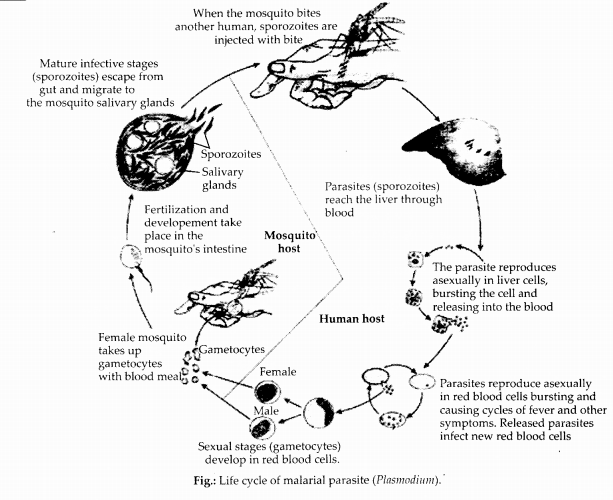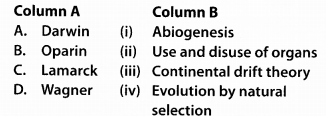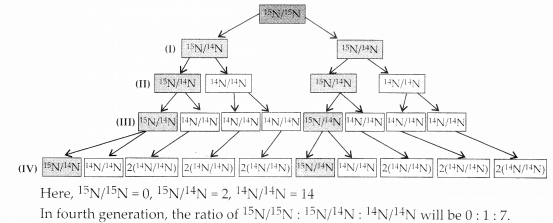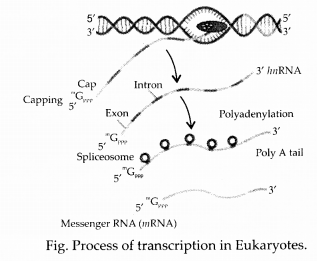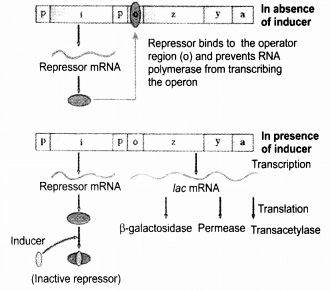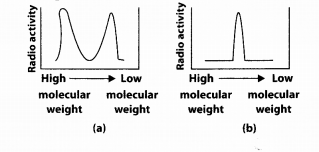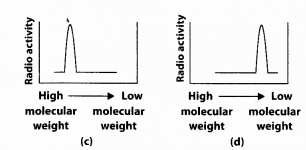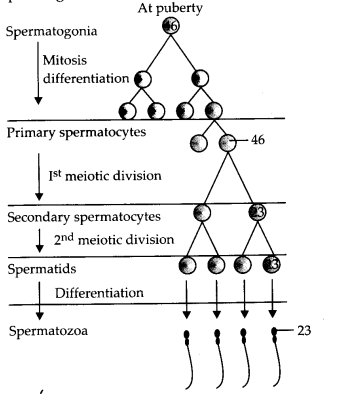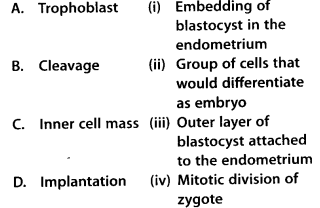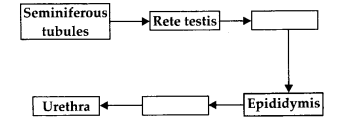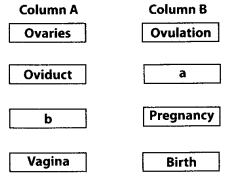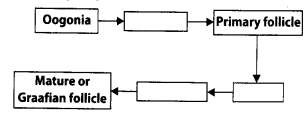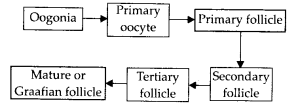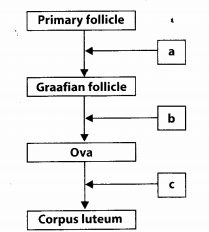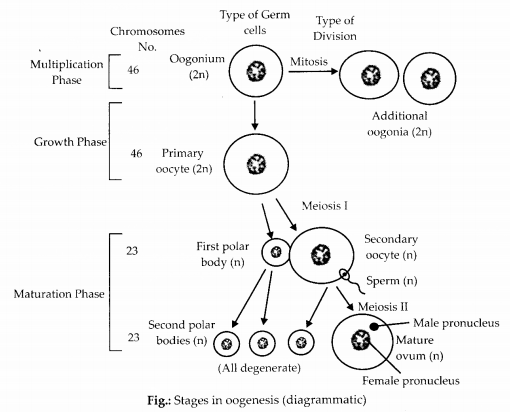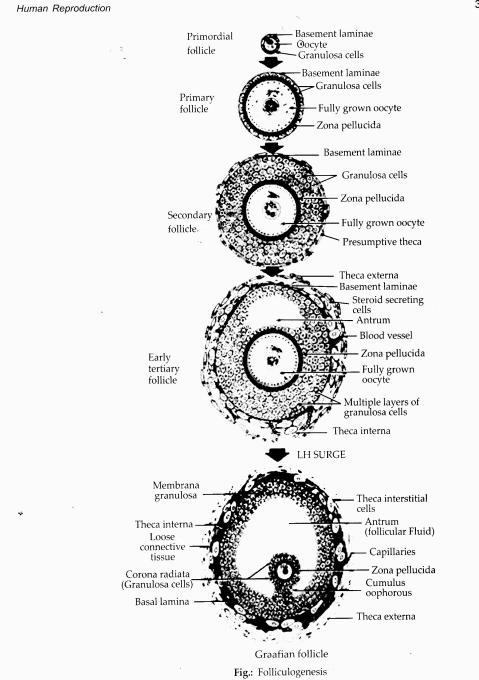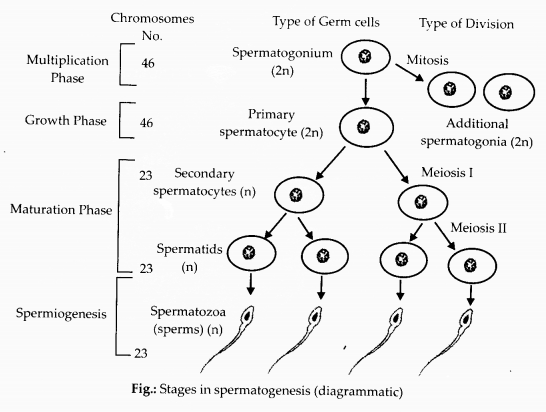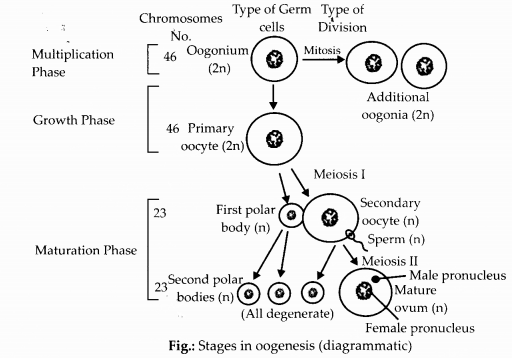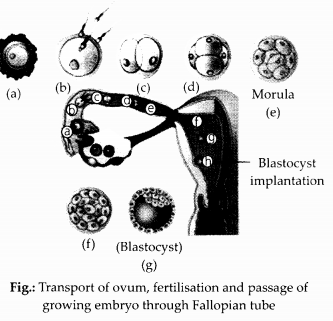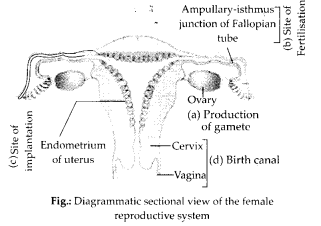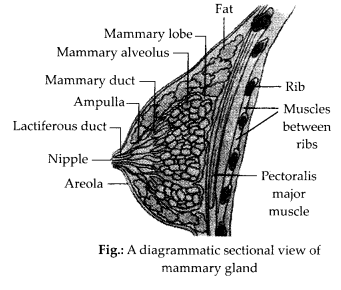NCERT Exemplar Solutions for Class 12 Biology chapter 9 Strategies for Enhancement in Food Production
These Solutions are part of NCERT Exemplar Solutions for Class 12 Biology. Here we have given NCERT Exemplar Solutions for Class 12 Biology chapter 9 Strategies for Enhancement in Food Production
Multiple Choice Questions
Question 1.
The chances of contracting bird flu from a properly cooked (above 100°C) chicken and egg are
(a) very high
(b) high
(c) moderate
(d) none.
Answer:
(d)
Question 2.
A group of animals which are related by descentand share many similarities are referred to as
(a) breed
(b) race
(c) variety
(d) species.
Answer:
(a)
Question 3.
Inbreeding is carried out in animal husbandry because it
(a) increases vigour
(b) improves the breed
(c) increases heterozygosity
(d) increases homozygosity.
Answer:
(d) : Breeding of animals of the same breed for 4-6 generations is called inbreeding. Thus, inbreeding is necessary if we want to develop a pureline. Inbreeding, as a rule, increases homozygosity.
Question 4.
Sonalika and Kalyan Sona are varieties of
(a) wheat
(b) rice
(c) millet
(d) tobacco.
Answer:
(a) Sonalika and Kalyan Sona are high yielding and disease resistant varieties of wheat.
Question 5.
Which one of the following is not a fungal disease?
(a) Rust of wheat
(b) Smutofbajra
(c) Black rot of crucifers
(d) Red rot of sugarcane
Answer:
(c) : The pathogen responsible for black rot of crucifer is a bacterium Xanthomonas campestris. It lives on the plant residue in the soil or in the seed. The bacterium enters leaves through the hydathodes. Bacteria may also enter leaves through wounds including those made by insects. First sign of the disease appears near the leaf margin, characterised by chlorosis, which progresses towards the center of leaf blade. In the affected portions, the vein and veinlets turn brown and finally black.
Question 6.
In virus-infected plants the meristematic tissues in both apical and axillary buds are free of virus because
(a) the dividing cells are virus resistant
(b) meristems have anti viral compounds
(c) the cell division of meristems are faster than the rate of viral multiplication
(d) viruses cannot multiply within meristem cell(s).
Answer:
(c)
Question 7.
Several South Indian states raise 2-3 crops of rice annually. The agronomic feature that makes this possible is because of
(a) shorter rice plant
(b) better irrigation facilities
(c) early yielding rice variety
(d) disease resistant rice variety.
Answer:
(c)
Question 8.
Which one of the following combination would a sugarcane farmer look for in the sugarcane crop?
(a) Thick stem, long internodes, high sugar content and disease resistant.
(b) Thick stem, high sugar content and profuse flowering.
(c) Thick stem, short internodes, high sugar content, disease resistant.
(d) Thick stem, low sugar content, disease resistant.
Answer:
(a)
Question 9.
Fungicides and antibiotics are chemicals that
(a) enhance yield and disease resistance
(b) kill pathogenic fungi and bacteria, respectively
(c) kill all pathogenic microbes
(d) kill pathogenic bacteria and fungi respectively.
Answer:
(b)
Question 10.
Use of certain chemicals and radiation to change the base sequences of genes of crop plants is termed
(a) recombinant DNA technology
(b) transgenic mechanism
(c) mutation breeding
(d) gene therapy.
Answer:
(c) : Mutation is the process by which genetic variations are created through changes in the base sequence within genes resulting in the creation of a new character or trait not found in the parental type. It is possible to induce mutations artificially
through use of chemicals or radiations (like gamma radiations), and selecting and using the plants that have desirable characters as a source in breeding. This process is called mutation breeding.
Question 11.
The scientific process by which crop plants are enriched with certain desirable nutrients is called
(a) crop protection
(b) breeding
(c) biofortification
(d) bioremediation.
Answer:
(c) : Breeding of crops with higher levels of vitamins and minerals or higher protein and healthier fats is called biofortification. This is the most practical aspect to improve nutritional value of food.
Question 12.
The term ‘totipotency’ refers to the capacity of a
(a) cell to generate whole plant
(b) bud to generate whole plant
(c) seed to germinate
(d) cell to enlarge in size.
Answer:
(a) : The capacity to generate a whole plant from any cell/explant is called cellular totipotency. Infact, a whole plant can be regenerated from any plant part (referred to as explant) or cell.
Question 13.
Given below are a few statements regarding somatic hybridisation. Choose the correct statements.
(i) Protoplasts of different cells of the same plant are fused.
(ii) Protoplasts from cells of different species can be fused.
(iii) Treatment of cells with cellulase and pectinase is mandatory.
(iv) The hybrid protoplast contains characters of only one parental protoplast.
(a) (i) and (iii)
(b) (i)and(ii)
(c) (i)and(iv)
(d) (ii) and (iii)
Answer:
(d) :When a hybrid is produced by fusion of somatic cells of two varieties or species, it is known as somatic hybrid. The process of producing somatic hybrids is called somatic hybridisation. First, the cell wall of the plant cells are removed by digestion with a combination of pectinase and cellulase. The plant cells without cell wall are called protoplasts. The fusion of protoplasts not only involves the fusion of their cytoplasm. but also their nuclei. The fused protoplasts are allowed to grow on culture medium. Soon they develop their own walls and are called somatic hybrid cells. The hybrid cells give rise to callus. Callus later differentiates into new plant with characters of two plants in one.
Question 14.
An explant is
(a) dead plant
(b) part of the plant
(c) part of the plant used in tissue culture
(d) part of the plant that expresses a specific gene.
Answer:
(c) : An explant is the plant part taken out to be grown in test-tube in special nutrient medium. It has the ability to produce whole new plant.
Question 15.
The biggest constraint of plant breeding is
(a) availability of desirable gene in the crop and its wild relatives
(b) infrastructure
(c) trained manpower
(d) transfer of genes from unrelated sources.
Answer:
(a ) : Conventional plant breeding results in hybrid varieties which had a tremendous impact on agricultural productivity over the last decades. Conventional plant breeding also has its limitations. First, breeding can only be done between two plants that are sexually compatible with each other. This limits the new traits that can be added to those that already exist in a particular species. Second, when plants are crossed, many traits that have undesirable effects on yield potential are transferred along with the trait of interest.
Question 16.
Lysine and tryptophan are
(a) proteins
(b) non-essential amino acids
(c) essential amino acids
(d) aromatic amino acids.
Answer:
(c)
Question 17.
Micropropagation is
(a) propagation of microbes in vitro
(b) propagation of plants in vitro
(c) propagation of cells in vitro
(d) growing plants on smaller scale.
Answer:
(b) : Micropropagation is the in vitro propagation of plants by rapidly multiplying stock plant material to produce a large number of progeny plants (clone), using modern plant tissue culture methods.
Question 18.
Protoplast is
(a) another name for protoplasm
(b) an animal cell
(c) a plant cell without a cell wall
(d) a plant cell.
Answer:
(c) : Refer Answer 13.
Question 19.
To isolate protoplast, one needs
(a) pectinase
(b) cellulase
(c) both pectinase and cellulase
(d) chitinase.
Answer:
(c) : Refer Answer 13.
Question 20.
Which one of the following is a marine fish?
(a) Rohu
(b) Hilsa
(c) Catla
(d) Common carp.
Answer:
(b) : Rohu, Catla and common carp are freshwater fish.
Question 21.
Which one of the following products of apiculture is used in cosmetics and polishes?
(a) Honey
(b) Oil
(c) Wax
(d) Royal jelly
Answer:
(c) : Abdominal glands of worker bees produce a secretion from which bee wax is made. It is used in the manufacture of many items like cosmetics, shaving cream, face cream, plaster, pencils, electric goods, toothpaste, lotions, furniture-polishes, boot- polishes, protective coating, ink paints and candles.
Question 22.
More than 70 per cent of livestock population is in
(a) Denmark
(b) India
(c) China
(d) India and China
Answer:
(d)
Question 23.
The agriculture sector of India employs about
(a) 50 per cent of the population
(b) 70 per cent of the population
(c) 30 per cent of the population
(d) 60 per cent of the population.
Answer:
(d) : India is an agricultural country. Agriculture accounts for approximately 33% of India’s GDP and employs nearly 62% of the population.
Question 24.
33 percent of India’s (Gross Domestic Product) comes from
(a) industry
(b) agriculture
(c) export
(d) small-scale cottage industries.
Answer:
(b) : Refer answer 23.
Question 25.
A collection of all the alleles of all the genes of a crop plant is called
(a) germplasm collection
(b) protoplasm collection
(c) herbarium
(d) somaclonal collection.
Answer:
(a) : The entire collection of plants/ seeds having all the diverse alleles for all the genes in a given crop is called germplasm collection.
Very Short Answer Type Questions
Question 1.
Millions of chicken were killed in West Bengal, Assam, Orissa and Maharashtra recently. What was the reason?
Answer:
Reason for killing of millions of chickens in West Bengal, Assam, Orissa and Maharashtra was spreading of bird flu caused by H5N1 strain of bird flu virus. This bird flu was spreading like an epidemic. Evidences showed that disease could affect many animals like cats, dogs, pigs, white tigers and also human beings.
Question 2.
Can gamma rays used for crop improvement programmes prove to be harmful for health? Discuss.
Answer:
Gamma rays are physical mutagens used to induce changes in DNA and chromosomes. ^ These are frequently employed in mutation breeding. Plants obtained by mutation breeding are high yielding and disease resistant. Useful plants with desirable mutations are selected for further breeding programmes. It has been found that such plants do not produce any harmful effect on health.
Question 3.
In animal husbandry, if two closely related animals are mated for a few generations, it results in loss of fertility and vigour. Why is this so?
Answer:
Inbreeding is the crossing of closely related animals of the same breed for 4-6 generations. Continuous inbreeding leads to
homozygosity. The recessive alleles tend to get together and express harmful effects in the progeny. Resulting in reduced survival and fertility of offspring known as inbreeding depression.
Question 4.
In the area of plant breeding, it is important not only to preserve the seeds of the variety being cultivated, but also to preserve all its wild relatives. Explain with a suitable example.
Answer:
Collection and preservation of all the different wild varieties, species and relatives of the cultivated species in plant breeding is essential for effective exploitation of natural genes a vai lable in the population. For example, in sugarcane (Saccharum officinarum) the character for disease resistance has been incorporated by breeding it with wild variety (Saccharum spontaneum).
Question 5.
Name a man-made cereal. Trace how it was developed and where is it used?
Answer:
Triticalc (6n) is a man-made cereal. It is a hexaploid variety developed by crossing wheat and rye followed by doubling of chromosomes. Triticale is the first man made crop.
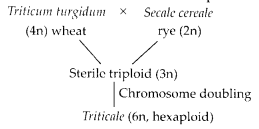
Question 6.
Fill in the blanks.
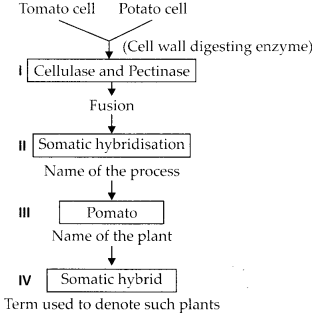
Answer:
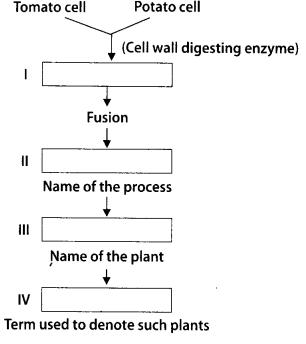
Question 7.
A few statements are given below followed by a set of terms in a box. Pick the correct term and write it against the appropriate statement.
(a) Mating of closely related individuals within the same breed.
(b) Mating of animals of same breed but having no common ancestors on either side for 4-6 generations.
(c) Mating of animals of two different species.
(d) Breeding of animals belonging to different breeds.
(i) Cross breeding,
(ii) Inter-specific hybridisation,
(iii) Outbreeding,
(iv) Outcrossing,
(v) Inbreeding.
Answer:
(a) – (v), (b) – (iv), (c) – (ii), (d) – (i)
Question 8.
What is meant by ‘hidden hunger’?
Answer:
Hidden hunger is consumption of food deficient in nutrients, particularly, in micronutrients, proteins and vitamins.
Question 9.
Why are plants obtained by protoplast culture called somatic hybrids?
Answer:
In protoplast culture, plants are obtained by fusion of somatic cells of two varieties, therefore, they are called somatic hybrids.
Question 10.
What is protoplast fusion?
Answer:
The plant cells without cell wall are called protoplasts. Protoplast fusion is the fusion of protoplasts of two plant cells by means of electro fusion or chemicals.
Question 11.
Why is it easier to culture meristems compared to permanent tissues?
Answer:
It is easier to culture meristems compared to permanent tissues because meristem is group of actively dividing and undifferentiated cells while cells of permanent tissues lose their ability to divide and have to dedifferentiate to resume their ability to divide.
Question 12.
Why are proteins synthesised from Spirulina called single cell proteins?
Answer:
Proteins synthesised from Spirulina are called single cell proteins (SCPs) because they are obtained from unicellular microorganism. The term is a misnomer as in SCP production, the biomass is produced from both unicellular and multicellular microorganisms, viz. bacteria, algae, fungi, etc.
Question 13.
A person who is allergic to pulses was advised to take a capsule of Spirulina daily? Give the reasons for the advice.
Answer:
Both Spirulina and pulses are rich sources of proteins. But if an individual is allergic to pulses, then he can take Spirulina capsule to fulfill the daily requirement of protein intake.
Question 14.
What is aquaculture? Give example of an animal that can be multiplied by aquaculture.
Answer:
Aquaculture is rearing and management of useful aquatic organisms such as aquatic plants and animals like fish, prawns, oysters etc., in both freshwater and saltwater under controlled conditions.
Question 15.
What are the duties of a veterinary doctor in management of a poultry farm?
Answer:
Duties of a veterinary doctor in management of poultry farm includes :
- Ensuring proper and safe conditions for establishment of poultry farm.
- Regular inspection of poultry birds to ‘protect them from diseases.
- Vaccination of poultry birds.
- Early detection of diseases followed by proper medication
Question 16.
Would it be wrong to call plants obtained through micropropagation as ‘clones’? Comment.
Answer:
No, it is not wrong to call plants obtained by micropropagation as clones because these plants will be genetically similar to each other and to the original plant.
Question 17.
How is a somatic hybrid different from a hybrid?
Answer:
A normal sexual hybrid is produced by fusion of ordinary gametes. The major limitation in creating a sexual hybrid is the sexual compatibility of two species. However, success in some cases can be achieved by hybrid-specific modifications used to achieve fusion of gametes, and to rescue, isolate and culture the developing embryo in vitro. Sexual hybrids are diploid and cytoplasmic contribution of fusing cells is unequal. Somatic hybrids result from the fusion of somatic cells instead of ordinary gametes. This technique requires specific handling of protoplasts and is totally dependent on tissue culture technique. Sexual compatibility is not at all, a barrier to this technique and it can be performed between sexually incompatible species. Somatic hybrids are generally tetraploid and cytoplasmic contribution of two fusing cells is equal to the hybrid.
Question 18.
What is emasculation? Why and when it is done?
Answer:
Emasculation is removal of anthers from a bisexual flower before its maturity. It is done during artificial hybridisation programme to avoid self-pollination.
Question 19.
Discuss the two main limitations of plant hybridisation programme.
R3JBW
The limitations of plant hybridisation programme are as follows:
- Availability of a limited number of identified disease resistant genes that are present in various crop varieties or wild relatives.
- Compatibility of parents.
Question 20.
Interspecific crosses are rare in nature and intergeneric crosses almost unknown. Why?
Answer:
In interspecific crosses, male and female animals of two different related species are mated. In some cases, the progeny may combine desirable features of both the parents, and may have considerable economic value, e.g., the mule. Intergeneric hybridisation is the crossing of two different animals/plants of different genera. Both interspecific and intergeneric crosses are rare in nature. Sexual incompatibility, reproductive isolation and sterility are the main barriers in crossing between non-related species. For example, plants belonging to different species do not flower at the same time and often do not use the same pollinators. Intergeneric hybrids more or less never form complete zygotes/embryos. These are sterile/ infertile.
Question 21.
Differentiate between pisciculture and aquaculture.
Answer:
Pisciculture is rearing and management of fish in water bodies. Aquaculture involves rearing and management of useful aquatic plants and animals, such as fish, prawns, crabs, molluscs etc.
Question 22.
Give two important contributions of Dr. M.S. Swaminathan.
Answer:
Dr. M. S. Swaminathan is called father of “Green revolution” in India. His contributions are as follows:
- of high-yielding varieties of wheat.
- Development of semi-dwarf, high- yielding rice varieties.
These helped in increasing the crop production and meeting requirements of increasing population.
Question 23.
The term ‘desirable trait’ can mean different thingsfor different plants. Justify the statement with suitable examples.
Answer:
Different plants have different desirable traits. This can be explained with example of rice. Certain rice areas in tropical Asia and Africa are subject to prolonged and deep flooding. In such areas, farmers grow floating rice with internodes that elongate when the wafer rises. These are not very good yielding varieties. Yet they are ‘desirable’ because internode elongation prevents them from getting submerged and dying. But in Latin America, where fields flood no deeper than 40 to 100 cm, that too for shorter periods, farmers prefer hybrids obtained by crossing deep water varieties with improved dwarfs which are superior, as they contain high yield combined with dwarfism.
Short Answer Type Questions
Question 1.
You are planning to set up a Dairy Farm. Describe the various aspects you would consider before you start the venture.
Answer:
Various aspects to be considered while setting up a dairy farm include:
-
- Selection of good breeds containing high yielding potential (under the climatic conditions of the area) and resistance to the diseases.
- Ensurance of adequate ventilation, suitable temperature, sufficient light, water and proper drainage channel in cattle shed.
- Emphasis on feeding cattle in scientific manner i.e., monitoring quantity and quality of fodder.
- Employing people with good knowledge of cattle hygiene, handling of cattle during milking and storage and transport of milk and its products.
- Proper arrangement of regular inspection by a veterinary doctor.
Question 2.
It is said, that diseases are spreading faster due to globalisation and increased movement of people. Justify the statement taking the example of H5N1 virus.
Answer:
bird flu virus affects the poultry birds and can turn into an epidemic. This disease can be transmitted to other animals like cats, dogs, white tigers or even human beings. It can also be transferred from one human being to another. Due to globalisation and increased movementof people, the disease spreads rapidly from one country to another. The spreading of disease also increases when affected products are imported from one country to another.
Question 3.
Explain the concept of the ‘Blue Revolution’.
Answer:
The term ‘Blue Revolution’ refers to the remarkable emergence of aquaculture as an important and highly productive activity. Aquaculture refers to all forms of active culturing of aquatic animals and plants occurring in fresh water, marine or brackish forms.
In India, it was started in 1970. ‘Blue Revolution’ has brought improvement in aquaculture by adopting new techniques of breeding, rearing, marketing and export of fish. It lead to tremendous increase in shrimp production.
Question 4.
A farmer was facing the problem of low yield from his farm. He was advised to keep a beehive in the vicinity. Why? How would the beehive help in enhancing yield?
Answer:
Bees are pollinators of many crop species such as sunflower, Brassica, apple and pear. Honey bees feed on pollen and nectar of flowers. Keeping beehive in crop fields during flowering period increases pollination efficiency and improves the yield (both crop and honey).
Question 5.
Lifestyle diseases are increasing alarmingly in India. We are also dealing with large scale malnutrition in the population, is there any method by which we can address both of these problems together?
Answer:
Increase in lifestyle diseases and malnutrition, both can be checked by biofortification. It is a technique to produce crops with high nutritional value with higher levels of vitamins, minerals, proteins and healthier fats.
A few examples of crop with improved food quality are :
- Maize hybrids have twice the amount of essential amino acids like lysine and tryptophan.
- Wheat variety with high protein content.
- Iron rich wheat variety.
- Carrots, spinach, pumpkin enriched with vitamin A.
- Bitter gourd, mustard, tomato enriched with vitamin C.
Question 6.
How can we improve the success rate of fertilisation during artificial insemination in animal husbandry programmes?
Answer:
Multiple Ovulation Embryo Transfer Technology (MOET) is used to improve the
success rate of fertilisation during artificial insemination. In this method, hormones (with FSH-like activity) are given to the cow for inducing follicular maturation and super ovulation i.e., instead of one egg, which they usually give per cycle, they produce 6-8 eggs. The cow is either mated with a best bull or artificially inseminated. The embryos at 8-32 cell stages are recovered and transferred to surrogate mothers. The genetic mother is available for another super ovulation. MOET has been done in cattle, sheep, rabbits, buffaloes, mares etc. High milk giving breeds of females and high quality (lean meat with less lipid) meat giving bulls have been bred successfully to obtain better breed in a short time.
Question 7.
What is meant by germplasm collection? What are its benefits?
Answer:
Germplasm collection refers to collection of variability. It involves collection and preservation of all different wild varieties, species and relatives of the cultivated species. It is sum total of all the alleles of the genes present in a crop. Germplasm collection is essential for successful breeding programme as it offers, to the breeders, the entire of genes and alleles and their characteristics which a plant expresses. The breeder is exposed to the best options and he can select the most favourable traits of a particular gene.
Question 8.
Name the improved characteristics of wheat that helped India to achieve green revolution.
Answer:
The term ‘Green Revolution’ refers to increase in crop yield due to development of high yielding varieties of crop plants like wheat and rice through plant breeding technique. Sonalika and Kalyan Sona are improved wheat varieties introduced in India for ‘Green Revolution’.
They show following characteristics:
- High yield
- Disease resistance
- Semi-dwarf habit
Question 9.
Suggest some of the features of plants that will prevent insect and pest infestation.
Answer:
Insect resistance in plants may be produced by morphological, biochemical or physiological features.
These are discussed as follows:
- Presence of hair growth on aerial plant parts, e.g., hairy leaves in cotton plant protect it from jassids.
- Rendering the flowers nectarless, e.g., nectarless cotton varieties provide protection from cotton bollworms.
- Low nitrogen and sugar content in stems prevent maize plants from stem borers.
- Solid stem in wheat is not preferred by stem saw fly.
Question 10.
It is easier to culture plant cells in vitro as compared to animal cells. Why?
Answer:
Plant cells are easier to culture in vitro because they have the property of cellular totipotency, i.e., capacity to generate whole plant from any cell. But in case of animals, whole new organism cannot be produced from single cell.
Question 11.
The culture medium (nutrient medium) can be referred to as a highly enriched laboratory soil’. Justify the statement.
Answer:
The plant tissue culture medium is referred to as highly enriched laboratory soil as it consists of both micro- and macro¬elements, vitamins, carbon source, amino acids and growth regulators required for the growth of explants.
Question 12.
Is there any relationship between dedifferen-tiation and the higher degree of success achieved in plant tissue culture experiments?
Answer:
In plants, living, differentiated cells, those who have lost the capacity to divide can regain the capacity of division under certain conditions. This is called dedifferentiation. Dedifferentiated cells undergo callus formation and callus gets differentiated to form plantlets.
Question 13.
“Give me a living cell of any plant and I will give you a thousand plants of the same type” Is this only a slogan or is it scientifically possible? Write your comments and justify them.
Answer:
Living cells of plants have property of totipotency, i.e., ability to form whole new plant jfrom any cell. Large number of plants can be produced from single cell by technique called micropropagation. In this method of tissues culture, each plant produced is genetically similar to parent plant.
Question 14.
What is the difference between a breed and a species. Give an example for each category.
Answer:
A ‘breed’ is a specific group of animals which share many similarities such as homogenous appearance, behaviour etc., that distinguish it from other animals or plants of the same species. Sahiwal is an indigenous breed, Jersey, Brown Swiss are exotic breeds of cattle (Bos indica).
A ‘species’ is the largest group of individuals capable of freely interbreeding among themselves and producing fertile offspring, e.g., all cows of the whole world have only one scientific name Bos indica.
Question 15.
Plants raised through tissue cultures are clones of the ‘parent’ plant. Discuss the utility of these plants.
Answer:
The plants obtained through tissue culture are genetically identical to parent plants. This is of great use when desirable characters of the parent plant have to be maintained. Hence, plant raised through tissue culture technique are of great use.
Question 16.
Discuss the importance of testing of new plant varieties in a geographically vast country like India.
Answer:
India is a vast country with varying climatic conditions. Different hybrid varieties after growing in research fields are evaluated by growing in farmer’s field, at least for three growing seasons at several locations in the country representing all agroclimatic zones. The hybrid is evaluated for various characters like disease resistance, tolerance, yield in comparison to the best available local crop cultivar. Testing of new plant varieties before release is of great importance as it ensures that the plant varieties can grow in vivid environmental conditions present in different geographical regions of our country.
Question 17.
Define the term ‘stress’ for plants. Discuss briefly the two types of stress encountered by plants.
Answer:
External factors which reduce the growth and yield of plants are known as stress. These external factors may be abiotic or biotic. Two common types of stress encountered by plants are:
- Water – Plants need sufficient water to grow. Less availability of water or drought is unfavourable and negatively affects growth and yield of the plant.
- Temperature – Plants require optimum temperature for their proper growth. Very high or very low temperature negatively affects the growth rate of plants.
Question 18.
Discuss natural selection and artificial selection. What are the implications of the latter on the process of evolution?
Answer:
Selection is the process by which certain individuals with desired characters and considered to be fit are favoured. Natural selection involves selection of adapted individuals by nature. It is a continuous process and has resulted in evolution. Evolution that takes place in natural selection is a slow’ process.
In artificial selection, parent organism with desirable characters, such as high yield, disease resistance, increased tolerance etc., is selected by humans and is hybridised with superior variety to produce hybrid.
Artificial selection provides a model that helps us understand natural selection. It is a small step to envision natural conditions acting selectively on populations and causing natural changes. Artificial selection allows rapid changes in a species. This is because man has one power which nature does not have – man ensures breeding that preserves only beneficial traits of species. Hence, evolution through artificial selection is much faster as compared to evolution through natural selection.
Question 19.
Discuss briefly how purelines are created in animal husbandry.
Answer:
When breeding is between animals of the same breed, it is called inbreeding. In animal husbandry, purelines are produced by inbreeding of animals for 4-6 generations.
Question 20.
What are the physical barriers of a cell in the protoplast fusion experiment? How are the barriers overcome?
Answer:
Physical barriers in protoplast fusion involve presence of protective cell wall in plant cells and then fusion of protoplasm. Cell wall is digested by cellulase and pectinase and then protoplasts of two cells are fused in a solution of polyethylene glycol (PEG) or by high voltage pulse, known as electrofusion.
Question 21.
Give few examples of biofortified crops. What benefits do they offer to the society?
Answer:
SPinn Examples of biofortified crops are :
- Maize variety rich in lysine and arginine.
- High protein content wheat varieties.
- Iron rich wheat variety.
- Vitamin A enriched carrots, pumpkin, spinach.
- Calcium and iron enriched spinach and bathua.
Biofortified crops help to improve the health of people and meet their daily requirements and thus alleviate malnutrition.
Long Answer Type Questions
Question 1.
You are a botanist working in the area of plant breeding. Describe the various steps that you will undertake to release a new variety.
Answer:
The steps required for developing new varieties are as follows:
(1) Collection of germplasm : Collection and preservation of all the different wild varieties, species and relatives of the cultivated species is a pre-requisite for effective exploitation of natural genes available in the population. Germplasm is the sum total of all the alleles of the genes present in a crop and its related species.
(2) Evaluation and selection of parents : The germplasm is evaluated to identify plants with desirable combination of characaters. Seeds of plants having desirable characters are selected for multiplication.
(3) Cross-hybridisation among selected parents : Hybridisation is the most common method of creating genetic variation. Hybridisation is crossing of two or more types of plants for bringing their traits together in the progeny. It brings about useful genetic/heritable variations of two or more lines together.
(4) Selection and testing of superior recom-binants : This step comprises selecting among the progeny of the hybrids, i.e., those plants that have the desired character combination. The selection process yields plants that are superior to both of the parents. These plants are self-pollinated for several generations till they come to a state of uniformity (homozygosity).
(5) Testing, release and commercialisation of new cultivars : The newly selected lines are evaluated in comparison to best available local crop cultivar for their yield and other agronomic traits of quality, disease resistance etc. and then are released for commercialisation.
Question 2.
(a) The shift from grain to meat diets creates more demands for cereals. Why?
(b) A 250 kg cow produces 200 g of protein per day but 250 g of Methylophillus methylotrophus can produce 25 tonnes of protein. Name this emerging area of research. Explain its benefits.
Answer:
(a) The shift from grain to meat diets creates more demands on cereals as it takes 3-10 kg of grain to produce 1 kg of meat by animal farming.
(b) The emerging research area discussed in the question refers to Commercial production of proteins from micro¬organisms, called single cell protein. Advantages of SCP are as follows:
- It provides a protein rich supplement in human diet.
- It reduces the pressure on agricultural production systems for the supply of the required proteins.
- SCP production is based on industrial effluents so it helps to minimise environmental pollution.
Question 3.
What are the advantages of tissue culture methods over conventional method of plant breeding in crop improvement programmes?
Answer:
Advantages of tissue culture method over conventional methods of breeding are :
- It is fast method of growing new plants.
- New plants can be produced from explants or even from single cell.
- New plants produced are genetically similar to the parents.
- Disease free plants can be produced.
- Purelines can be created easily.
Question 4.
Modem methods of breeding animals and plants can alleviate the global food shortage’. Comment on the statement and give suitable examples.
Answer:
The population of the world is increasing day by day. To meet the food requirements of the ever increasing population, is the major concern of plant and animal breeders. Modern biological principles are applied to animal husbandry and plant breeding to enhance food production.
Modem methods in animal breeding include Multiple Ovulation Embryo Transfer Technology (MOET). In this method, hormones (with FSH-like activity) are given to the cow for inducing follicular maturation and super ovulation i.e., instead of one egg, which they usually give per cycle, they produce 6-8 eggs. The cow is either mated with a best bull or artificially inseminated. The embryos at 8-32 cell stage are recovered and transferred to surrogate mothers. The genetic mother is available for another super ovulation. MOET has been done in cattle, sheep, rabbits, buffaloes, mares, etc. High milk yielding breeds of females and high quality (lean meat with less lipid) meat-giving bulls have been bred successfully to obtain better breed in a short time.
Modern methods in plant breeding include the following:
- Tissue culture which is an in vitro technique of regeneration of a whole plant from any part of a plant (explant) by growing it on culture medium under aseptic conditions.
- Biofortification which is the method for developing crops with higher levels of vitamins, minerals, proteins and healthier fats to improve public health.
- Producing single cell protein as an alternative protein source for animal and human nutrition from certain beneficial microorganisms like Spirulim.
Question 5.
Does apiculture offer multiple advantages to farmers? List its advantages if it is located near a place of commercial flower cultivation.
Answer:
Advantages of apiculture to farmers are:
- It provides honey which has nutritional as well as medicinal advantage.
- It provides bee wax used in cosmetics, paints, polish etc.
- It provides bee venom used to cure gout and arthritis.
- It provides royal jelly used as a tonic by heart patients and growing children.
- Bees are pollinating agents. If they are kept in field during flowering season they feed on nectar and pollen to produce honey, and bring about effective pollination of crop plants thereby increasing crop yield.
Question 6.
(a) Mutations are beneficial for plant breeding.Taking an example, justify the statement,
(b) Discuss briefly the technology that made us self-sufficient in food production.
Answer:
(a) Mutation is the process by which genetic variations are created through changes in the base sequence within genes resulting in the creation of a new character or trait. It is possible to induce mutations artificially in plants through use of chemicals or radiations and then selecting and using those plants that have the desirable characters or traits as a source in breeding. This process is called mutation breeding.
Some important achievements of mutation breeding are:
- In mung bean, resistance to yellow mosaic virus and powdery mildew were introduced by mutations.
- Resistance to yellow mosaic virus in bhindi was transferred from a wild variety and resulted in new variety called Parbhani Kranti.
- High yielding Mexican wheat varieties were originally red grained. The colour was not liked by the Indians. Their cultivation was adopted in India on large scale only when exposure to gamma radiations converted them to amber grained through mutations, e.g., Sharbati Sonora (from Sonora 64), Pusa Lerma (from Lerma Rojo 64A).
(b) After independence, efforts to make country self sufficient for food were not successful for two decades. It was a major task for agricultural scientists in India to produce sufficient food for increasing population with little land available. The positive results appeared only in the form of ‘Green Revolution’. Basic aims of Green Revolution were:
- Expansion of existing farm lands.
- Doubling cropping in existing farm lands.
- Use of genetically improved varieties. Plant breeding as a technology helped increase food production to a great extent. By using this technology, high yielding varieties of wheat, rice, millet and corn were developed. Tremendous growth was observed in industries and it created many opportunities for new jobs. As a result, India was transformed from a starving nation to the exporter of food.
Question 7.
Discuss how the property of plant cell totipotency has been utilised for plant propagation and improvement.
Answer:
Totipotency is the ability of single cell to grow into complete new plant. Plant * cell totipotency can be utilised for plant propagation and improvement. Any part of a plant (explant) is taken out and is grown in test tube under sterile conditions in special nutrient medium. Plant hormones present in the culture medium play an important role in growth and differentation of cultured cells and tissues.”
By meristem culture, virus-free plants can be generated from an infected plant. Anther cells can be cultured in vitro to produce haploid plants. These are useful for immediate expression of mutations and quick formation of purelines. Young embryos can be cultured in vitro. Embryo culture is useful in case of orchids as orchid seeds do not have any form of stored food. Moreover in certain species, inhibitors present in the endosperm or seed coat make the seed dormant. Such embryos can escape dormancy by culturing on suitable medium.
Question 8.
What are three options to increase food production? Discuss each giving the salient features, merits and demerits.
Answer:
Traditional farming can only yield a limited biomass as food for humans and animals. Better management practices and increase in agricultural land can increase yield, but only to a limited extent.
Following are the three options to increase food production:
(a) Single cell protein : The biomass obtained from microorganisms can be treated or processed in industry to be used as food and is called single cell protein.
Merits of single cell proteins:
- Its production reduces pollution as it uses wastes and industrial effluents.
- It provides a protein-rich diet.
- It fulfills the demand of protein for human diet and takes off the pressure on agriculture system.
Demerits of single cell proteins:
- Sometimes the microbial biomass when taken as diet supplement may lead to allergic reactions.
- Many types of microorganisms produce substances which are toxic to the humans and also to the animals.
(b) Biofortification : It is the method for developing crops with higher levels of vitamins, minerals proteins and healthier fats to improve public health.
Merits of biofortification :
- It can potentially improve nutritional value of food and other health benefits.
- It can help combat various lifestyle diseases and malnutrition.
Demerits of biofortification :
- Its successful implementation into society requires safe delivery systems, stable policies, appropriate social infrastructures.
- It requires continuous financial support from government.
(c) Tissue-culture :
It is an in vitro technique for regeneration of a whole plant from any part of a plant by growing it on culture medium under aseptic conditions.
Merits of tissue culture :
- A large number of plants can be grown in short time.
- Disease-free plants can be multiplied.
- Seedless plants can be multiplied.
- Characters of the plants where sexual reproduction is absent can be combined using somatic hybridisation.
Demerits of tissue culture :
- It requires great expense because it needs latest techniques in the laboratory.
- It requires acclimatisation of plants grown by tissue culture to the external environment.
- It requires special expertise.
We hope the NCERT Exemplar Solutions for Class 12 Biology chapter 9 Strategies for Enhancement in Food Production help you. If you have any query regarding .NCERT Exemplar Solutions for Class 12 Biology chapter 9 Strategies for Enhancement in Food Production, drop a comment below and we will get back to you at the earliest.
